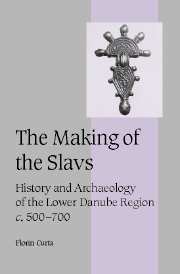Book contents
- Frontmatter
- Contents
- List of figures
- List of tables
- Acknowledgments
- List of abbreviations
- Introduction
- 1 Slavic ethnicity and the ethnie of the Slavs: concepts and approaches
- 2 Sources for the history of the early Slavs (c. 500–700)
- 3 The Slavs in early medieval sources (c. 500–700)
- 4 The Balkans and the Danube limes during the sixth and seventh centuries
- 5 Barbarians on the sixth-century Danube frontier: an archaeological survey
- 6 Elites and group identity north of the Danube frontier: the archaeological evidence
- 7 “Kings” and “democracy”: power in early Slavic society
- Conclusion: the making of the Slavs
- Appendix A
- Appendix B
- References
- Index
- Cambridge Studies in Medieval Life and Thought Fourth series
7 - “Kings” and “democracy”: power in early Slavic society
Published online by Cambridge University Press: 08 July 2009
- Frontmatter
- Contents
- List of figures
- List of tables
- Acknowledgments
- List of abbreviations
- Introduction
- 1 Slavic ethnicity and the ethnie of the Slavs: concepts and approaches
- 2 Sources for the history of the early Slavs (c. 500–700)
- 3 The Slavs in early medieval sources (c. 500–700)
- 4 The Balkans and the Danube limes during the sixth and seventh centuries
- 5 Barbarians on the sixth-century Danube frontier: an archaeological survey
- 6 Elites and group identity north of the Danube frontier: the archaeological evidence
- 7 “Kings” and “democracy”: power in early Slavic society
- Conclusion: the making of the Slavs
- Appendix A
- Appendix B
- References
- Index
- Cambridge Studies in Medieval Life and Thought Fourth series
Summary
One of the most persistent stereotypes about the early medieval history of Eastern Europe is that, at the time of their migration, the Slavs were organized in a “polyarchic tribal society with no elevated notion of sovereignty.” No Clovis or Theoderic arose among the Slavs to gather their scattered communities into a state and attempt a symbiosis with the Greco-Roman civilization of Byzantium. Incapable of organizing themselves on the state level, the Slavs could not escape being conquered by Goths, Huns, or Avars, who thus eliminated any incipient aristocracy the Slavs may have developed. The idea of the political inferiority of the Slavs in the Middle Ages, in contrast with a Germanic stratified society, is not new. It may be traced back as far as Herder's notion of a “democratic,” egalitarian Slavic societ. Today, the notion of the politically “primitive” Slavs of the early Middle Ages is a commonplace. This idea is primarily based on Procopius' frequently cited description of the Sclavenes and the Antes in the mid-500s: “For these nations, the Sclavenoi and Antae, are not ruled by one man, but they have lived from of old under a democracy (ἐν δημοκρατίᾳ ἐκ παλαιοũ βιοτεύουσι), and consequently everything which involves their welfare, whether for good or for ill, is referred to the people (ἐς Кοινòν ἄγεται)”. Some have argued that “democracy” is derisively applied here to what, in Procopius' eyes, might have been the opposite of Byzantine monarchy.
- Type
- Chapter
- Information
- The Making of the SlavsHistory and Archaeology of the Lower Danube Region, c.500–700, pp. 311 - 334Publisher: Cambridge University PressPrint publication year: 2001

